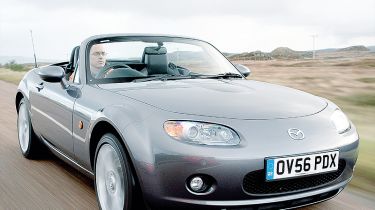Mazda MX-5 Convertible review
The RC has a clear advantage over the standard MX-5, particularly in the winter months. The electric folding hard-top makes the MX-5 a more mature and desirable car without losing its sense of fun.

Driving
The RC (Roadster Coupe) adds up to more than the sum of its parts. It feels a more solid and upmarket product than the soft-top model it complements in the MX-5 line-up. But although it's mechanically identical, 1.8-litre and 2.0-litre engines do feel like they've lost a few horsepower. That's because The RC is slightly heavier than the soft-top. Even so, choose the range-topping Sport with its six-speed gearbox and shorter gear ratios make it feel more enthusiastic - and having a sixth means lower revs at motorway speeds. As for dynamics, the larger gap for the stowed roof means some chassis stiffness is lost, but reinforcing brackets compensate. And since the roof adds rigidity, the hard-top is marginally stiffer. This allowed Mazda to fit a bigger front anti-roll bar and toughen the suspension. The results are marked - there's less shake over mid-corner ridges and ruts. So the hard-top isn't just quieter, but also smoother to drive.
Marketplace
Why build a folding hard-top MX-5? Surely it's just a showcase for the company's talents? Not so; it was driven by demand from existing owners seeing extra comfort and safety. The 20mm-thick solid roof is constructed from plastic composite, so is resistant to knife attacks, and joins a slightly higher, longer rear deck in ringing the changes over the soft-top. The roof is claimed to be the fastest on the market today; we recorded 14.5 seconds, though we can lower the manual coupe's roof 10 seconds faster! Looking classier and better-integrated than the soft-top, Mazda expects the hard-top to account for 35 per cent of MX-5 sales. It comes in better-stocked form than soft-tops; air con is standard. This means prices are higher, but as most soft-top owners choose it anyway, the 'real' price difference is minimal; another tick in the RC's favour. Besides, it's debatable whether this is a big issue - as, since the demise of the MG TF and Toyota MR2, the MX-5 has so few natural rivals!
Owning
Step inside and there's not much to choose between the RC and soft-top. The third-generation MX-5 has a clean, modern cabin, which is constructed from tactile materials, and the driving position is good, if still a touch high. The large glass rear screen means visibility is better than in the soft-top, and because it lets in more light, the cabin feels less enclosed. The rear window is mounted closer behind you though, and the RC has 30mm less headroom. Luggage space is less of a concern. Provided you keep the lid up, there's a deep pit behind the seats (the area the roof folds into) and the 150-litre boot hasn't shrunk at all during the conversion. Mazda claims the RC is 8dB quieter, but that's optimistic - in our tests, the advantage was only 2dB. It's still enough to make a difference, though. As for retained values, they're likely to prove even better than the soft-top's already glittering values; our experts predict it'll hold onto nearly 55 per cent of its value after three years. And running costs are generally identical to the soft-top; insurance ratings, fuel economy, servicing costs, all remain the same.







